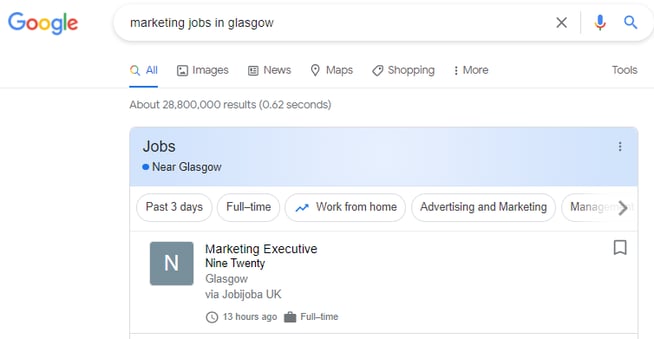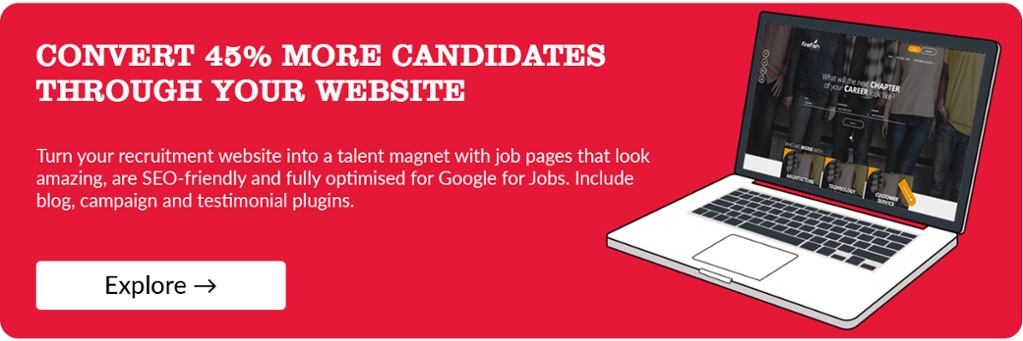It’s that million-dollar question we all want an easy answer to: How do I get my recruitment website to rank on Google?
While the answer is far from straight forward, the good news is, there are a few things you can do to give your recruitment website a good SEO boost and it’s the perfect time to do it.
In a recent Firefish survey, only 11% of agency managers said they’ll be making SEO a focus in 2022. Which means less competition for you!
Here are some basic tips that will help you improve your recruitment website’s visibility on Google:
1. Be strategic with your keyword phrases

Before you write a blog post or create recruitment copy for any page on your website, think first about your keyword phrases. What terms are candidates or clients likely to type into Google when searching on jobs and recruitment?
Use a free keyword tool (I use this one from Wordstream) to find keyword opportunities that are less competitive so are easier to rank for. And once you know what keyword you’re targeting, work it into your page title, description, and body content.
Stick to one main keyword per page as it’s difficult to rank for more than one keyword phrase for one page (unless it’s a slight variation, for example ‘how to find marketing jobs in Glasgow’ vs. ‘jobs in marketing Glasgow’).
2. Localise
By now, we’ve all come to terms with the idea that Google knows where we live. Any time you search for something online, search engines will look specifically for keywords related to your location so you get the most relevant results.
As a recruitment business, you should really capitalise on this. For example, you can include locations in some of your keywords (see example above) and URLs so your content appears more frequently in candidate searches in your target locations.
You should also make sure you have created a Google My Business page and clarify job location on every job page - otherwise Google won't scrape your jobs for Google for Jobs searches.
Which takes me to my next point…
3. Optimize your job ads
If your job ads aren’t optimized for SEO and Google for Jobs ready, you won’t stand a chance appearing in candidate job searches.
As you can see from the screenshot below, if a candidate performs a job-related Google search, the Google for Jobs snippet is the first thing they see:

To ensure Google scrapes your job ads so they appear in Google for Jobs, you need to have the appropriate schema in place, and include the right information that Google looks for in order to add jobs to the snippet feature.
There’s a whole load of opportunities involved in getting your jobs Google for Jobs ready – this Google for Jobs playbook has everything you need to know.
4. Produce YouTube content
Since Google bought YouTube back in 2006, creating video content for your recruitment YouTube channel has become a brilliant hack for getting quick visibility in search engines.
Essentially, you just want to start creating video content around the keyword phrases you want to rank for. And you don’t need any expensive video equipment to create professional video content either – here’s how to record and edit recruitment videos on an iPhone.
5. Remember meta data matters
When you create a web page for your website, you’ll be asked you to give each page of your website a title and meta description.
You won’t see meta data appear anywhere obvious on your website, but it’s really important for SEO. Meta titles and descriptions are what appears in SERP (search engines ranking pages).
Here’s what they look like:

Google considers your page titles and descriptions as a summary of the content on your page, and it uses them to figure out whether your page is relevant to a search. That’s why it’s so important to use your keyword in a descriptive title that will help search engines understand what your page is about.
Think of your meta description as your website page's elevator pitch – why would someone want to click and read it?
6. Use alt tags
Alternative text descriptions, otherwise known as ‘alt tags’, are the words you add into your website content management system (CMS) to describe the images you upload onto your website.
Alt tags are important for helping search engine crawlers to locate your pages and understand what the page is about so they can provide readers with the most relevant results. Not only this, but they improve accessibility for those who use screen readers to browse the internet.
Note that alt tags are not an opportunity for keyword stuffing – they should just describe what’s in the picture. So for example, a good alt tag would be ‘two men in black suits shaking hands’; a bad alt tag would be something like ‘hire a chartered accountant London’ for the same picture.
7. Keep up with Google algorithm changes
Just when you think you’ve got your SEO strategy nailed, Google decides that 65 characters is too long for a title, or that adding keywords to your alt text is a good idea after all. As crazy as this sounds, Google makes changes to its algorithm around once a day!
This means that the rules for SEO best practice are constantly changing. To stay on top of any changes, it’s a good idea to sign up to mailing lists of SEO industry blogs like Search Engine Watch, SEOmoz, and Search Engine Land. They’re not recruitment-related but they will keep you in the know about any changes that could impact your SEO strategy.
It’s also a good idea to use an SEO tool like SE Ranking, Moz or Semrush to perform regular audits of your recruitment website. These tools will scan your whole site for things that could be negatively impacting your ranking so you can fix broken links, identify pages with slow loading speeds, images that are too large, etc.
Think of it like a monthly SEO spring clean that will help push you further up search results.
8. Publish relevant, quality content
Publishing regular quality content on your recruitment website is the number one strategy to improve your website’s ranking on Google. And unfortunately, no – there’s no quick substitute for great content. You just have to put the resources in to get results.
Every time you add a new quality blog post or a clear and well-written page describing something about your recruitment services, you’ll be increasing your chances of visibility on Google.
Never be tempted to use stock copy, pay pennies for badly-written content or worse – rip off someone else’s content from a competitor’s site. Google can easily pull out duplicate content and if it finds any plagiarism, it will push your website right down in search results.
Download: How to create a content marketing plan for your agency
9. Update your content regularly
Updating your website regularly isn’t just a good way of getting candidates to come back; it’s also a good way of getting Google to come back.
Fresh, relevant content is proven to give your website a helping hand up the search results page.
You can keep things current even if you don’t have lots of fresh jobs to post: a news page or a recruitment blog can help.
10. Build up backlinks
‘Backlinks’ are links on other websites that send traffic to you. To build on your backlinks, you essentially just need to create a recruitment website worth linking to!
If Google can see that other trustworthy websites are linking to you, it will see you as a trustworthy source and bump you up in search results.
The best place to begin with 'link building' (the process of asking other websites to link to pages of your website) is your recruitment clients. Got a happy client you work regularly with? Ask them to link back to your website somewhere on their site (if they have a partners page, that’s the perfect spot).
Not only will you reap the benefit of referrals from their site, but your SEO should also improve.
Katie Paterson
Katie once headed up the Firefish blog and marketing team. She now works as a freelance copywriter and continues to contribute to our award-winning blog.





